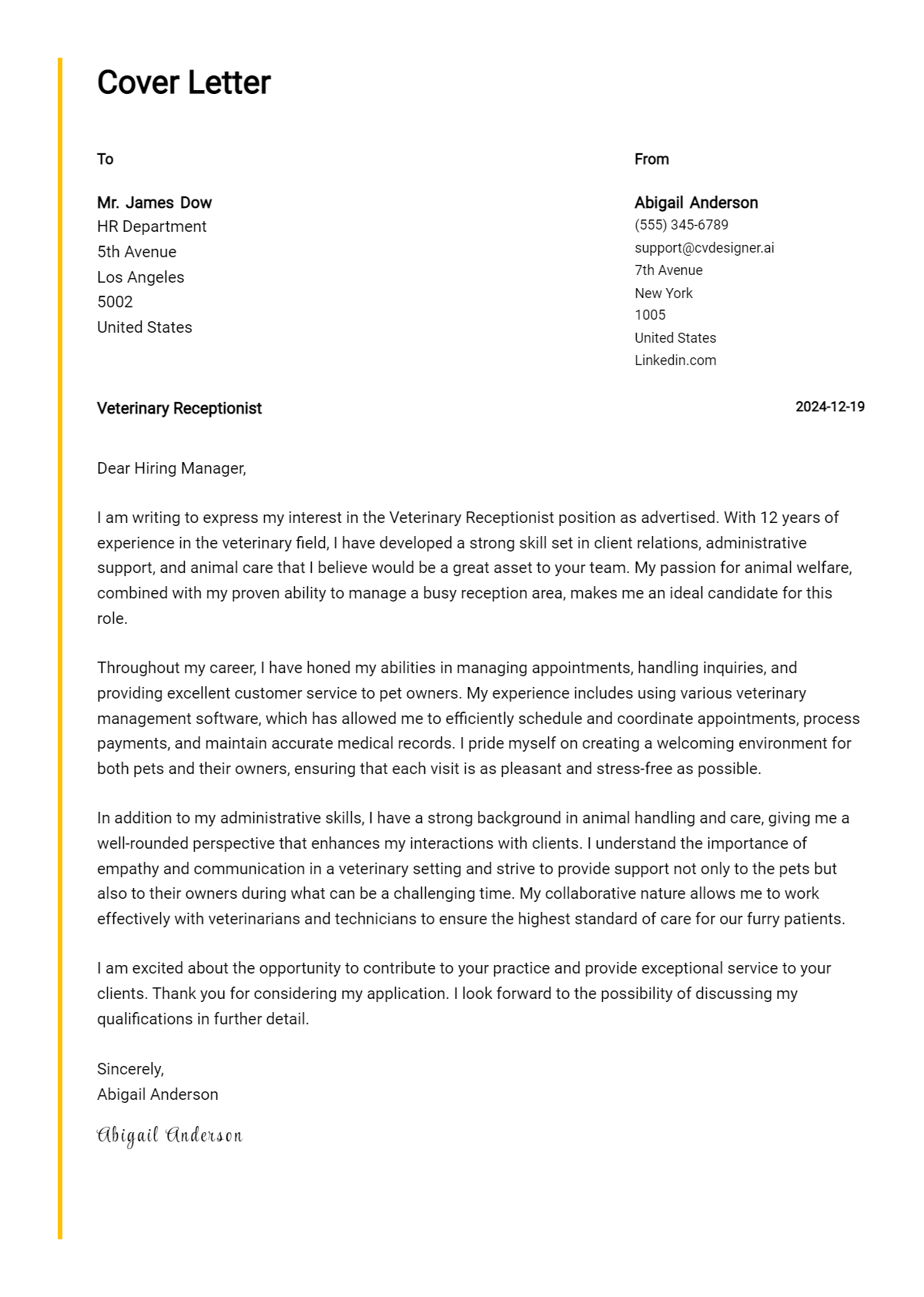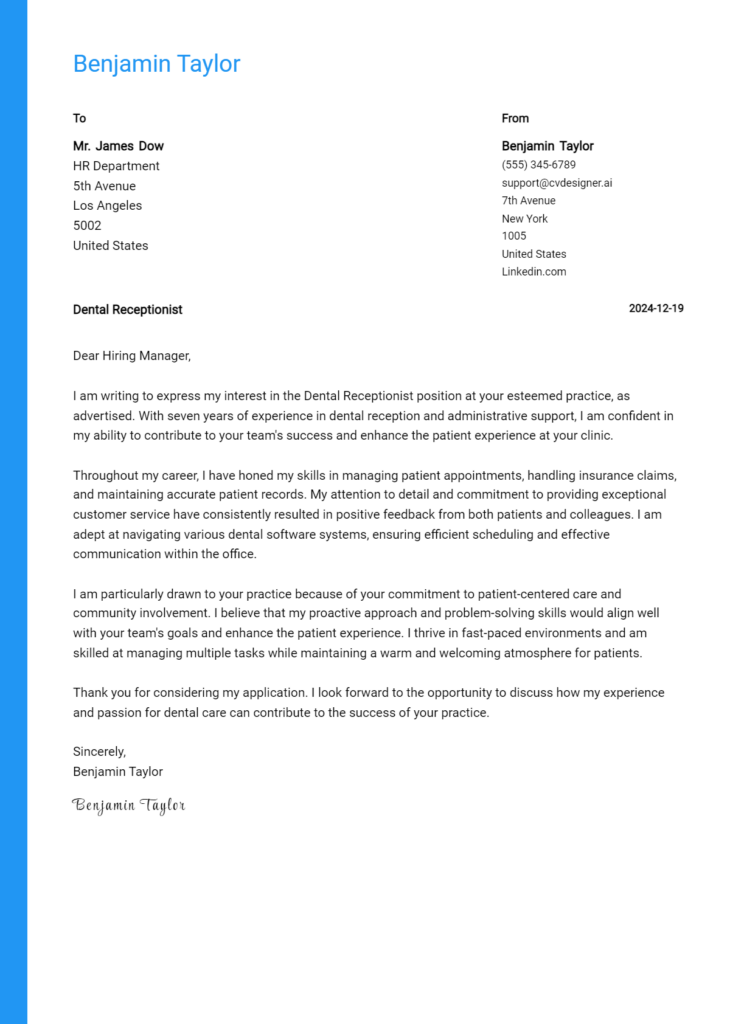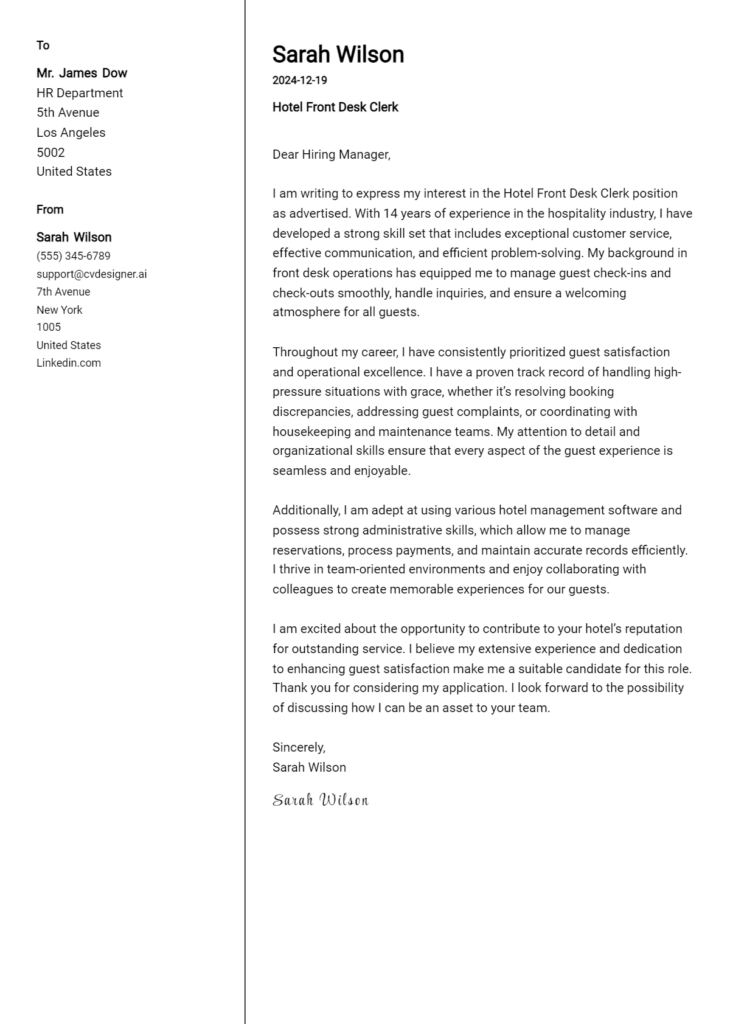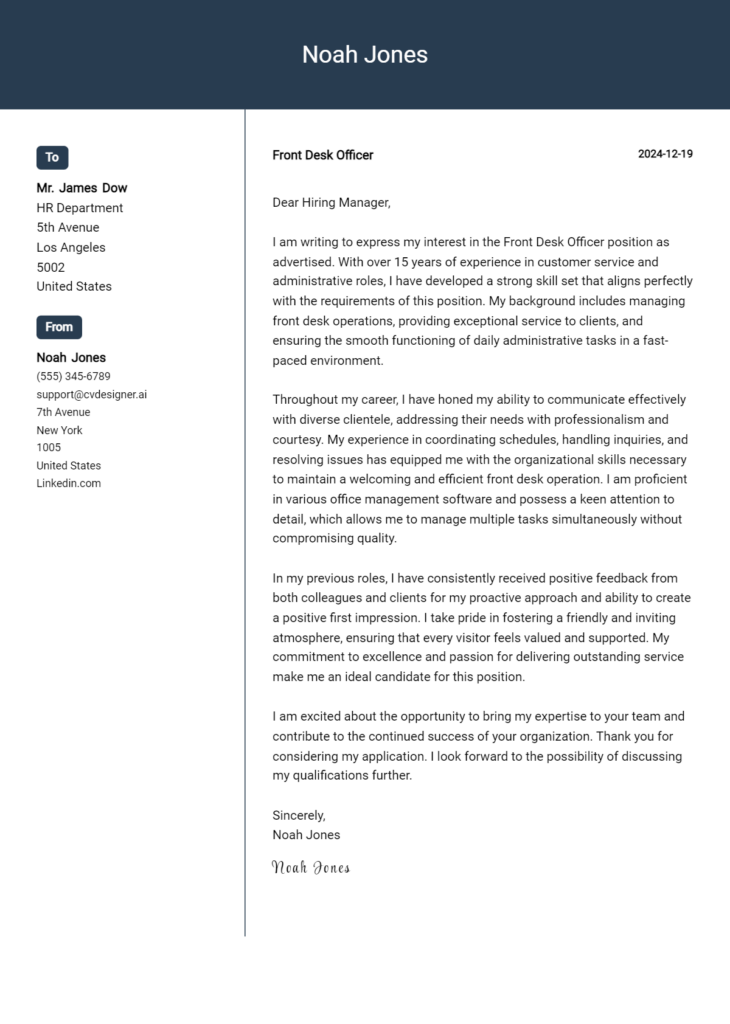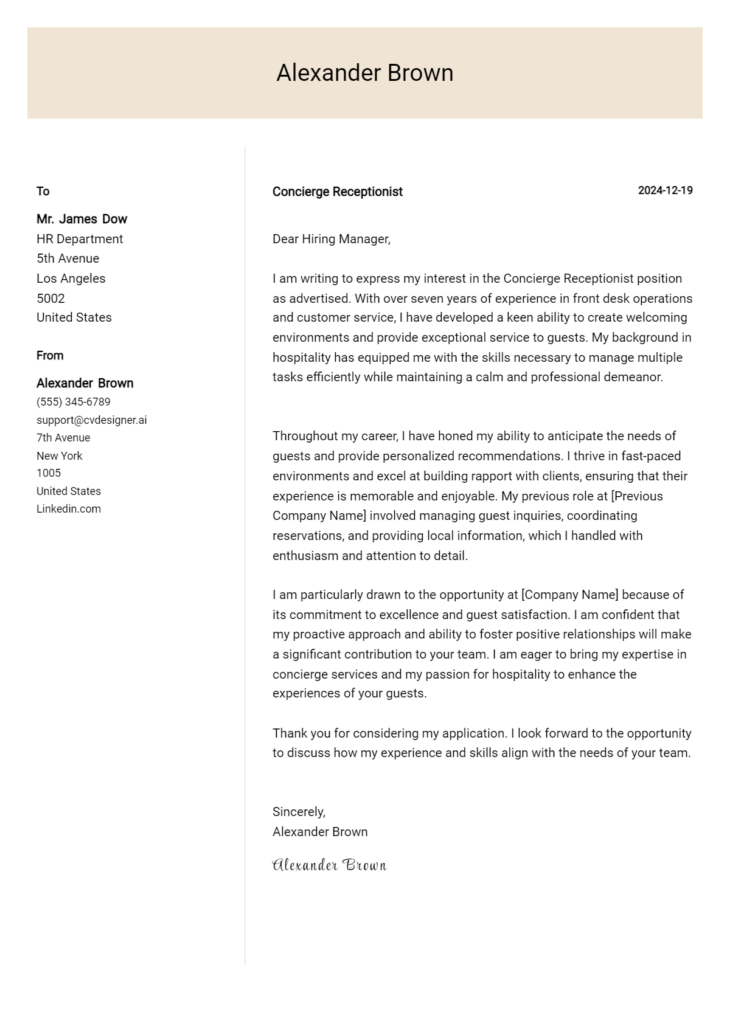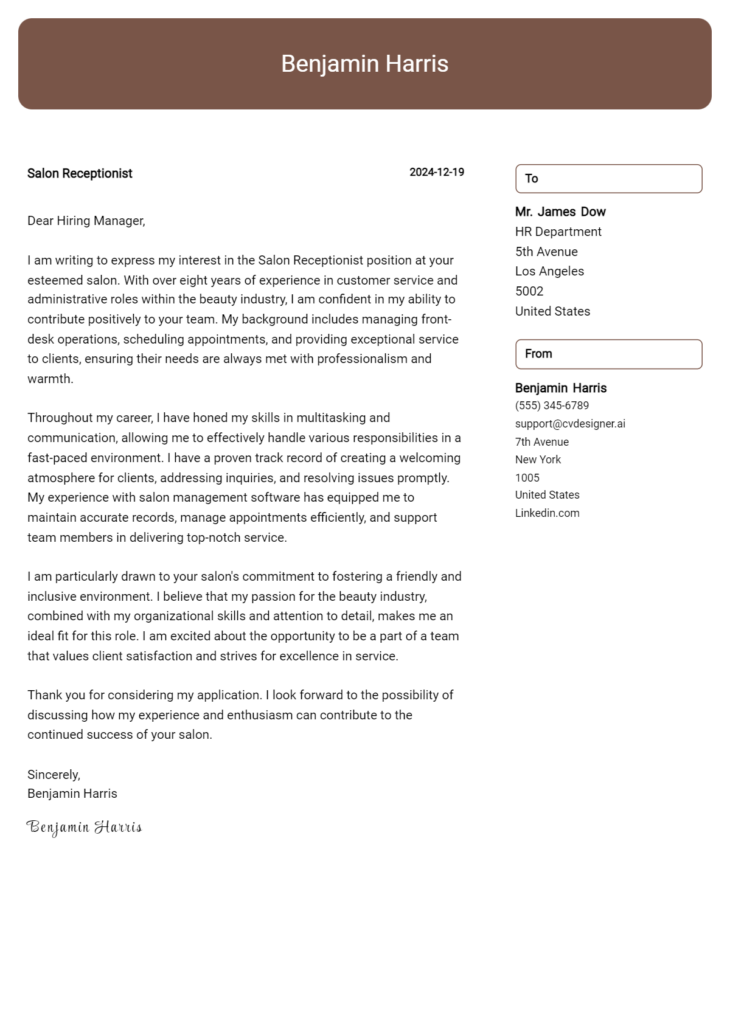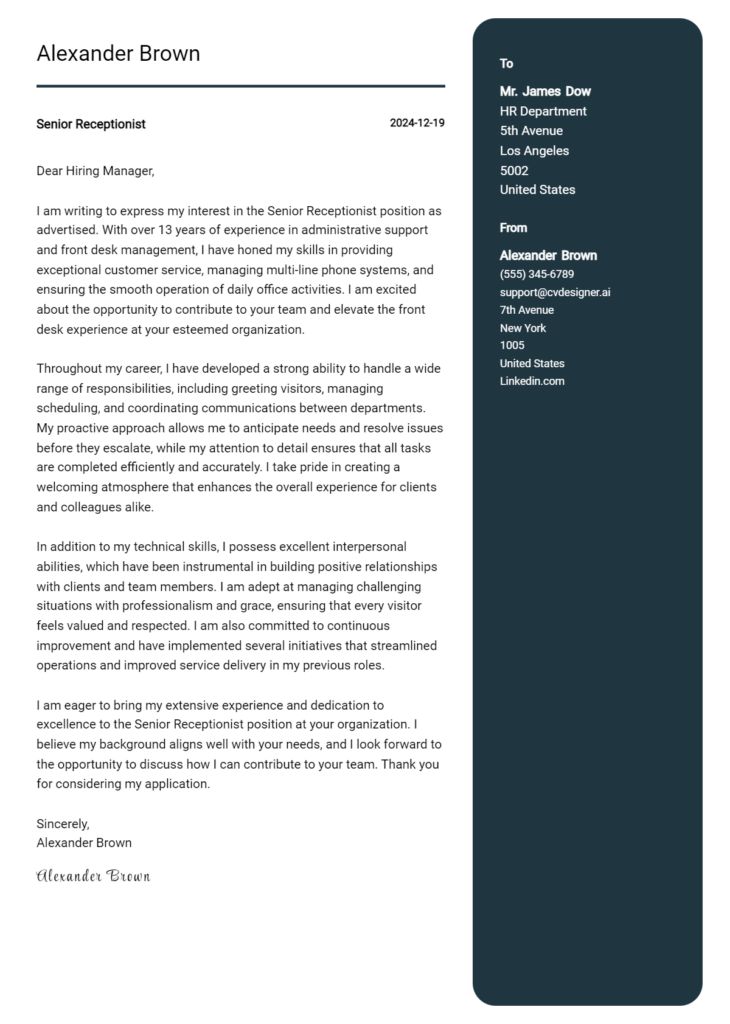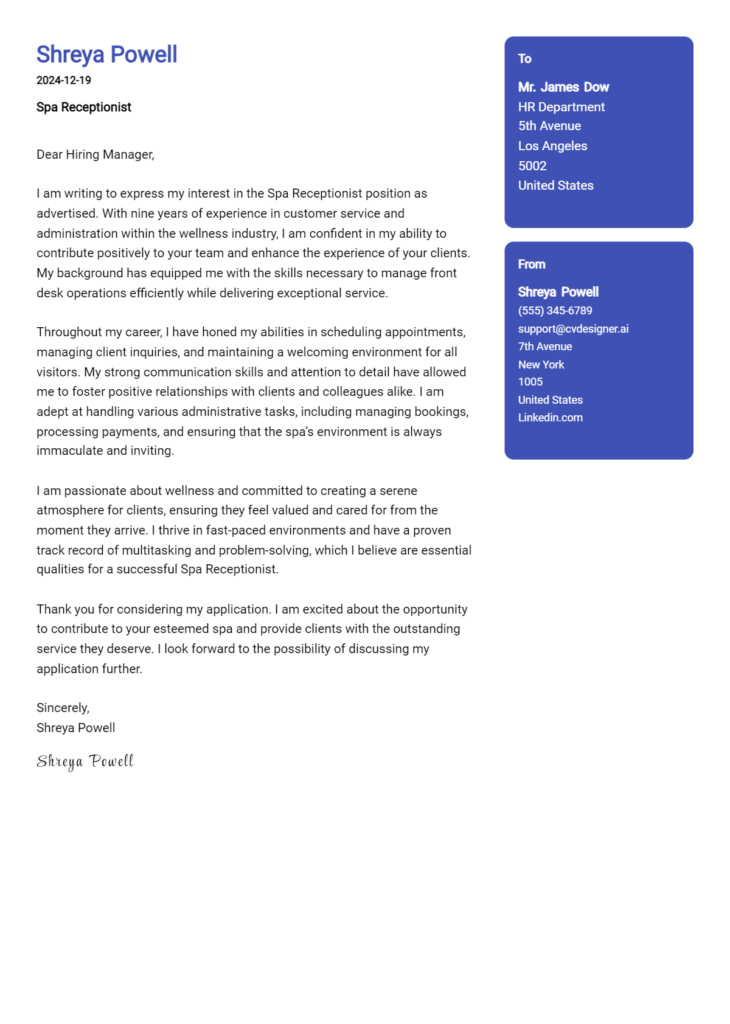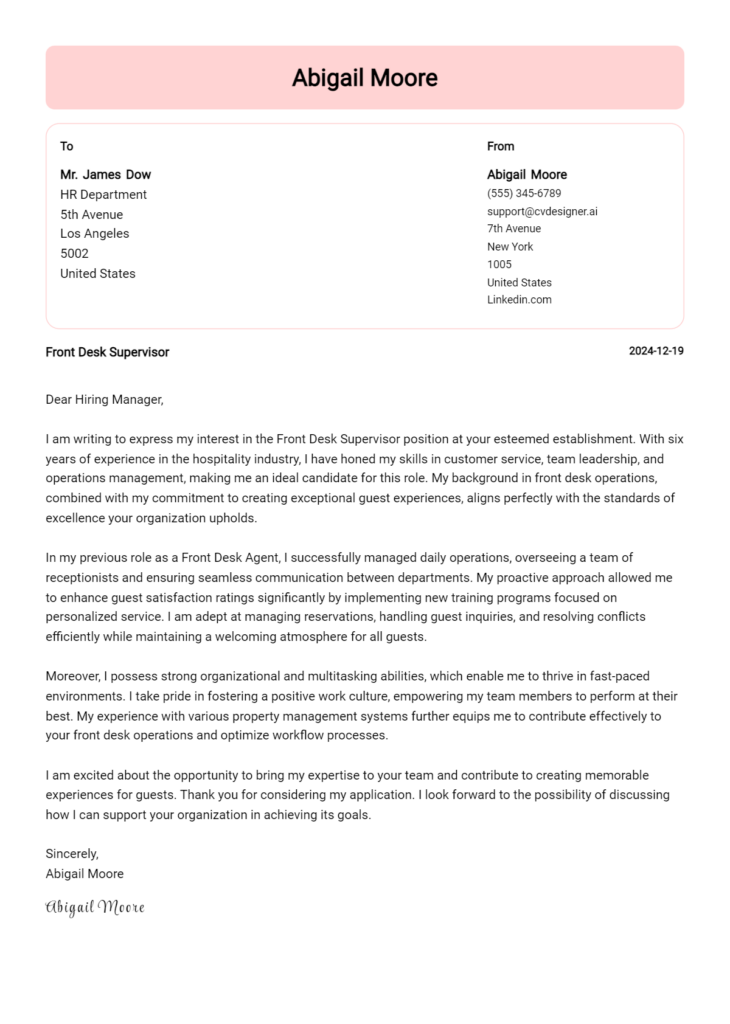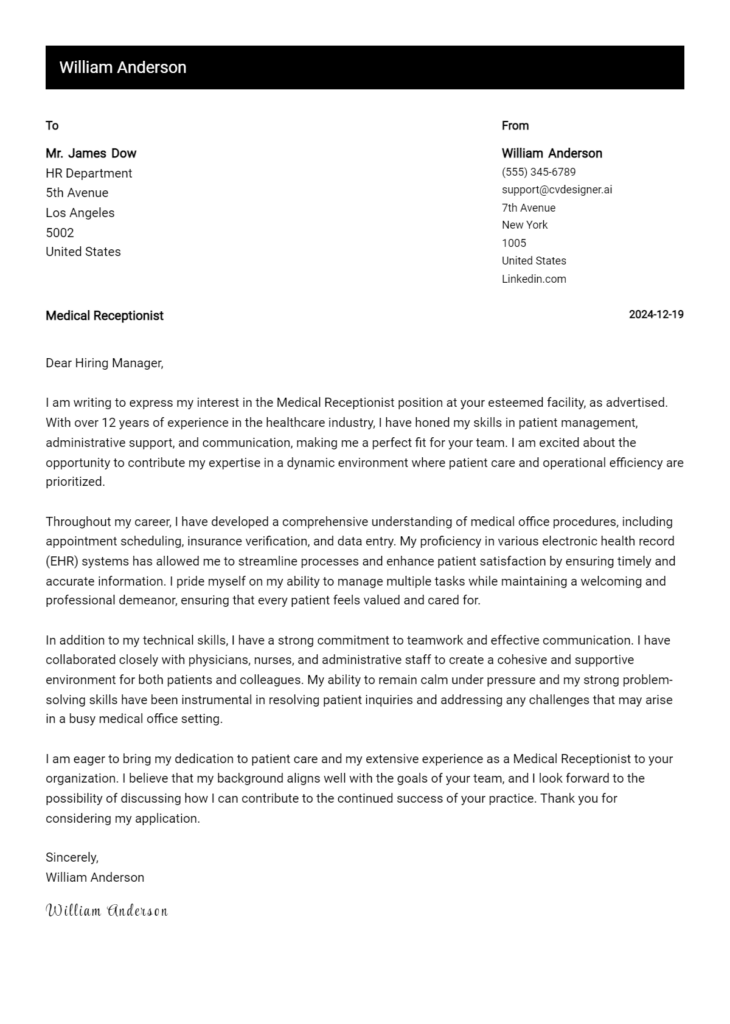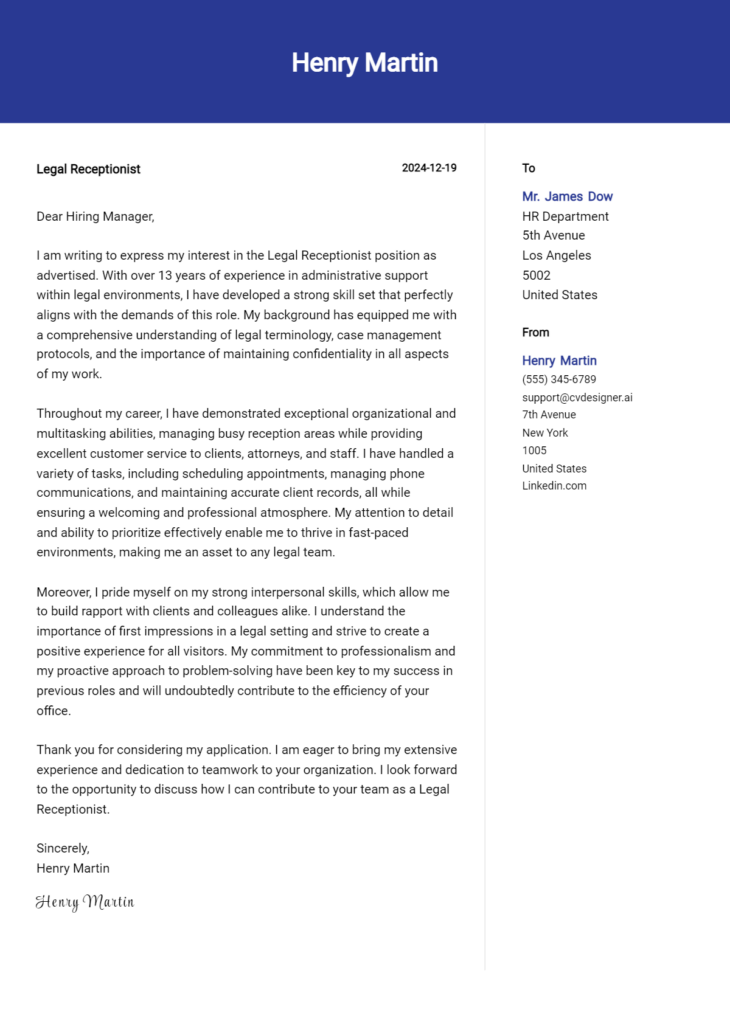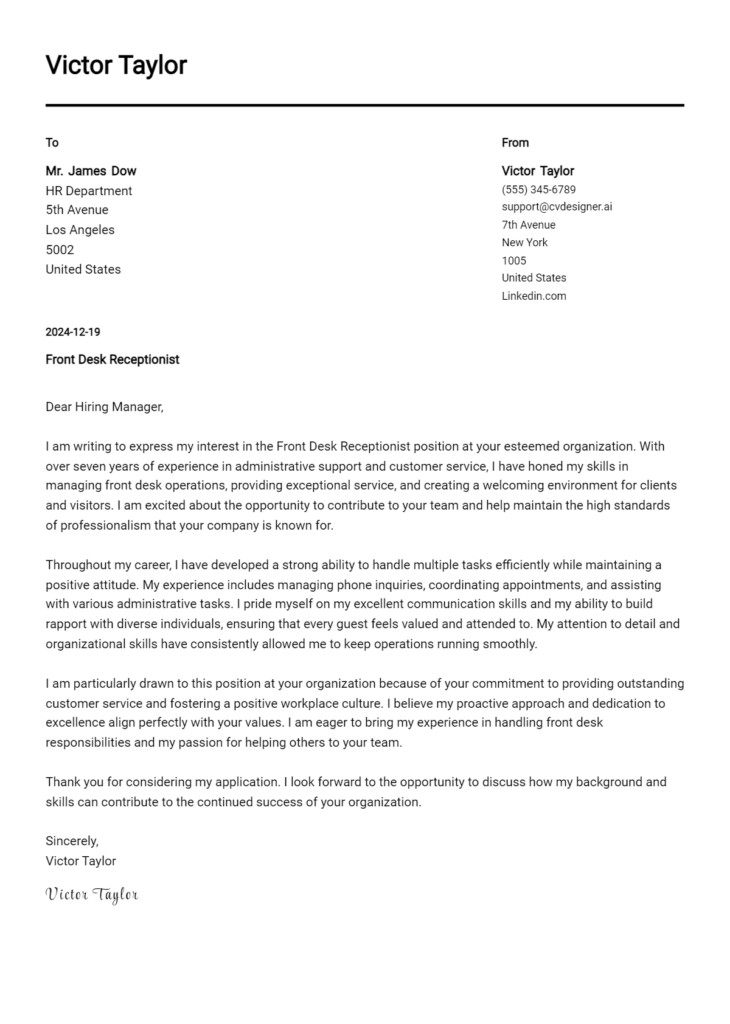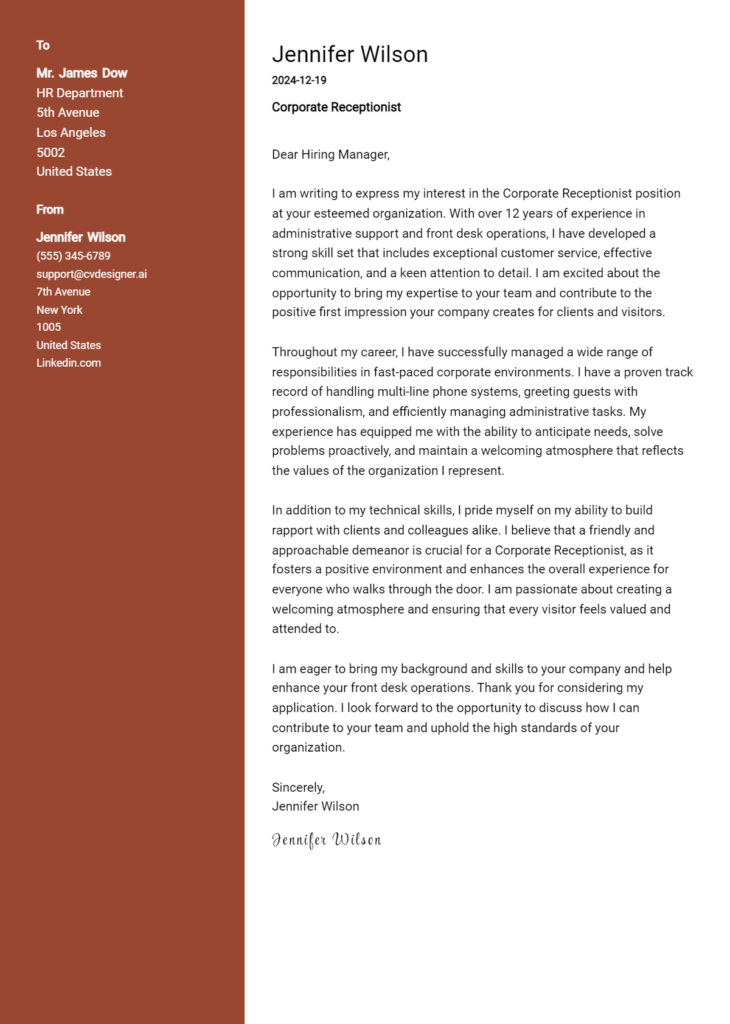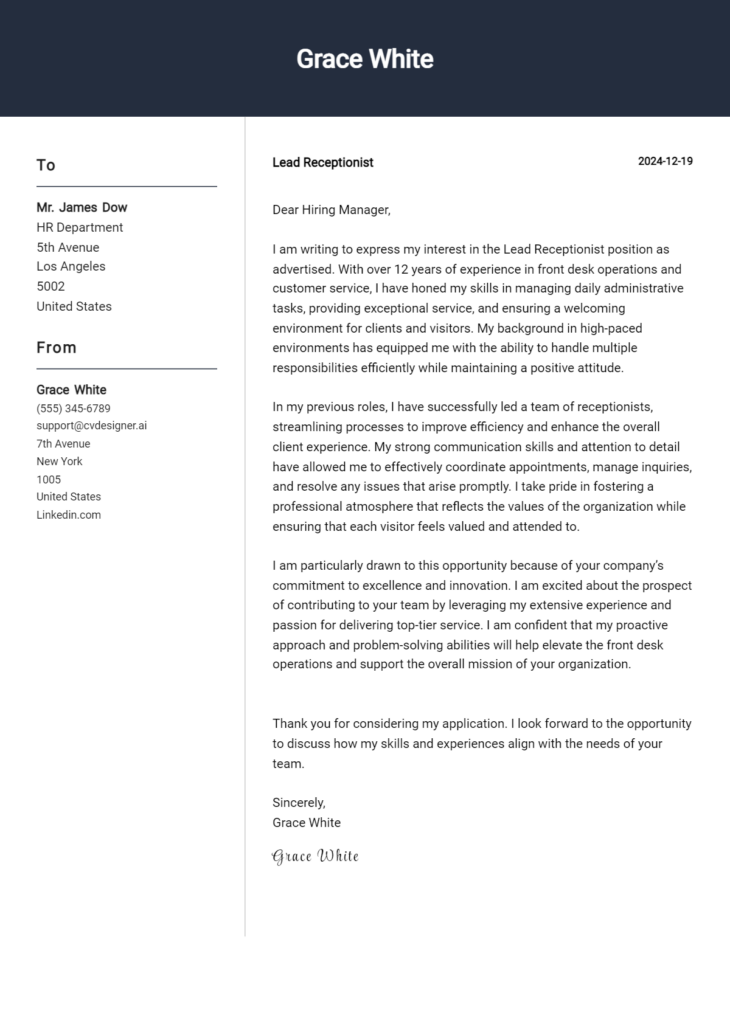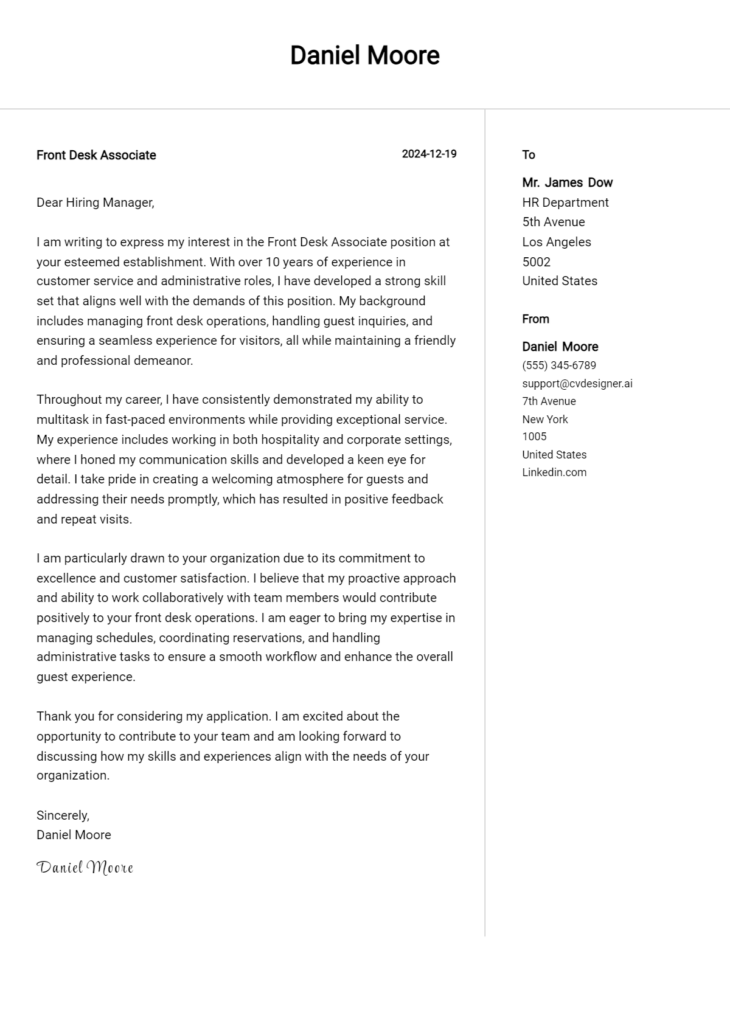Veterinary Receptionist Cover Letter Examples
Explore additional Veterinary Receptionist cover letter samples and guides and see what works for your level of experience or role.
How to Format a Veterinary Receptionist Cover Letter?
Crafting an effective cover letter is crucial for a Veterinary Receptionist, as it not only showcases your qualifications but also demonstrates your ability to communicate clearly and compassionately. The way you format your cover letter reflects your organizational skills and your commitment to providing excellent customer service—qualities that are essential in a veterinary setting. A well-structured cover letter can capture the attention of hiring managers, highlighting your suitability for the role and your passion for animal care.
In this guide, we’ll explore the key elements of a professional cover letter, helping you present your skills in the best light.
We will focus on the essential components of a veterinary receptionist cover letter, including:
- Cover Letter Header
- Cover Letter Greeting
- Cover Letter Introduction
- Cover Letter Body
- Cover Letter Closing
Each section is vital in highlighting your qualifications and professionalism. Let’s break down each part and explain how to make your veterinary receptionist cover letter shine.
Importance of the Cover Letter Header for a Veterinary Receptionist
The header of a cover letter is crucial as it sets the tone for the entire document and provides essential information at a glance. For a Veterinary Receptionist position, clarity and professionalism are paramount, as this role often serves as the first point of contact for clients and their pets. A well-structured header should include the applicant's contact information, the date, and the recipient's details, ensuring that the letter is easily traceable and conveys a sense of organization. A strong header reflects attention to detail, which is vital in a veterinary setting, while a weak header may create confusion or appear careless.
Strong Example
Jane Doe 123 Paw Print Lane Pet City, CA 90210 janedoe@email.com (555) 123-4567 March 1, 2024 Dr. John Smith Happy Paws Veterinary Clinic 456 Animal Avenue Pet City, CA 90210
Weak Example
Jane Doe@petmail.com March 1 Happy Paws Vet Clinic
The Importance of a Strong Cover Letter Greeting for a Veterinary Receptionist
The greeting of your cover letter is the first impression you make on a potential employer, and it sets the tone for the rest of your application. A well-crafted greeting demonstrates your professionalism and shows that you are serious about the position. By addressing the hiring manager directly, you add a personal touch that can make your application stand out. It’s important to avoid generic greetings like "To Whom It May Concern," as they can come across as impersonal and lazy. Instead, take the time to research the recipient's name, which reflects your commitment and attention to detail. This small effort can go a long way in making a positive impact.
Strong Greeting Example
Dear Dr. Smith,
Weak Greeting Example
To Whom It May Concern,
The Importance of a Well-Crafted Cover Letter Introduction for a Veterinary Receptionist
A well-crafted cover letter introduction is crucial for capturing the attention of the hiring manager and setting the tone for the rest of the application. For a Veterinary Receptionist, this introduction should not only express genuine interest in the role but also highlight relevant skills and achievements that align with the responsibilities of the position. A strong introduction can make a lasting impression, showcasing the candidate's enthusiasm for animal care and customer service, while a weak introduction may fail to engage the reader, potentially diminishing the chances of securing an interview.
Strong Example
Dear [Hiring Manager's Name], I am thrilled to apply for the Veterinary Receptionist position at [Clinic/Hospital Name], where my passion for animal care and my extensive experience in customer service can contribute to the compassionate environment you provide. With over three years of experience in a busy veterinary clinic, I have honed my skills in managing patient records, scheduling appointments, and ensuring a welcoming atmosphere for clients and their beloved pets. I am eager to bring my dedication and expertise to your team, helping to enhance the exceptional care you offer at [Clinic/Hospital Name].
Weak Example
To Whom It May Concern, I would like to apply for the Veterinary Receptionist job. I have worked in a few jobs before, and I think I might be good at this one too. I like animals, and I hope to get hired.
Purpose of the Cover Letter Body for a Veterinary Receptionist
The cover letter body for a Veterinary Receptionist serves as a crucial platform for candidates to articulate their relevant skills and experiences while demonstrating their potential value to the veterinary practice. This section allows applicants to highlight specific projects or accomplishments that reflect their proficiency in customer service, administrative tasks, and animal care. By showcasing their ability to manage schedules, handle client communications, and support veterinary staff, candidates can effectively convey how their past experiences align with the needs of the practice. A well-crafted cover letter can differentiate a candidate in a competitive job market, illustrating not only their qualifications but also their passion for animal care and commitment to excellent service.
Strong Example
Dear [Hiring Manager's Name], I am excited to apply for the Veterinary Receptionist position at [Veterinary Clinic Name]. With over three years of experience in a fast-paced veterinary environment, I have developed a strong skill set in client relations and office management. In my previous role at [Previous Clinic Name], I implemented a new scheduling system that reduced appointment wait times by 20%, significantly enhancing client satisfaction. My ability to communicate effectively with pet owners and empathize with their concerns has been crucial in fostering a welcoming atmosphere. I am also proficient in managing medical records and ensuring compliance with health regulations, which I believe will contribute to the smooth operation of your clinic. Sincerely, [Your Name]
Weak Example
Dear [Hiring Manager's Name], I want to apply for the Veterinary Receptionist position. I have worked in a few jobs, but I think this one is interesting. I like animals and I think I can answer phones and help customers. I have done some things, but I am not sure what they are right now. I hope you consider me for the job. Thanks, [Your Name]
The Importance of a Strong Cover Letter Closing for a Veterinary Receptionist
A well-crafted closing paragraph in your cover letter is crucial as it summarizes your qualifications, reiterates your enthusiasm for the Veterinary Receptionist position, and encourages the employer to take the next steps. A strong closing can leave a positive impression, prompting the hiring manager to review your resume and consider scheduling an interview. Conversely, a weak closing may fail to convey your suitability for the role or your eagerness to move forward in the hiring process.
Strong Example
Thank you for considering my application for the Veterinary Receptionist position at [Clinic Name]. With my strong background in customer service, proficiency in managing scheduling software, and a passionate commitment to animal welfare, I am excited about the opportunity to contribute to your team. I look forward to the possibility of discussing my application further and am eager to share how my skills can benefit your clinic. Please feel free to contact me to schedule an interview at your earliest convenience.
Weak Example
I hope you look at my resume. I think I would be good for the Veterinary Receptionist job. Let me know if you want to talk.
These tips will help candidates craft an effective cover letter for a Veterinary Receptionist position, emphasizing the importance of demonstrating key competencies that are essential in this role. A well-written cover letter not only highlights your technical skills and problem-solving abilities but also showcases your understanding of the software development life cycle (SDLC), ability to work in a team, and commitment to continuous learning in the veterinary field. Here are five detailed tips to guide you in creating a standout cover letter.
Tips for Writing an Effective Cover Letter for a Veterinary Receptionist
Highlight Relevant Technical Skills
As a Veterinary Receptionist, familiarity with medical software and scheduling systems is crucial. Make sure to mention specific programs you've used, such as veterinary practice management software. For example, you could say, "I am proficient in using [specific software], which has enabled me to efficiently manage appointment schedules and patient records." This demonstrates your preparedness for the role and your ability to adapt to new technologies.Showcase Problem-Solving Abilities
Veterinary receptionists often face unique challenges, from managing client inquiries to handling unexpected scheduling conflicts. Share a specific example of a time you navigated a difficult situation, such as resolving a client's concern or finding a last-minute appointment slot. This not only demonstrates your problem-solving skills but also highlights your commitment to client satisfaction.Demonstrate Knowledge of the SDLC
Understanding the software development life cycle can set you apart, especially if the veterinary practice utilizes customized software solutions. While you may not be directly involved in development, mentioning your awareness of the stages of SDLC shows that you are tech-savvy and willing to collaborate with IT teams to improve operational efficiency.Emphasize Teamwork and Collaboration
A veterinary practice thrives on effective teamwork. Mention your experience working in collaborative environments, highlighting how you contributed to team success. For instance, you could write, "In my previous role, I collaborated closely with veterinarians and technicians to streamline communication, ensuring that all patient needs were met promptly." This demonstrates your ability to work well with others and your understanding of the dynamics in a veterinary setting.Express a Passion for Continuous Learning
The veterinary field is constantly evolving, and showing a commitment to continuous learning is essential. Mention any recent courses, certifications, or workshops you’ve attended that are relevant to veterinary practice. For instance, "I recently completed a course in animal behavior, which has enhanced my ability to assist clients effectively and understand their pets' needs." This not only showcases your dedication to personal growth but also your eagerness to bring new knowledge to the team.
By incorporating these tips into your cover letter, you can create a compelling narrative that showcases your qualifications for the Veterinary Receptionist position. For additional support, consider using cover letter templates or a cover letter builder to streamline the writing process.
Common Mistakes to Avoid in a Veterinary Receptionist Cover Letter
Crafting a compelling cover letter is essential for making a strong first impression as a Veterinary Receptionist. Avoiding common mistakes can significantly enhance your chances of landing an interview. Here are some pitfalls to watch out for:
- Generic Greeting: Using "To Whom It May Concern" can make your letter feel impersonal. Instead, address the hiring manager by name if possible.
- Lack of Specificity: Failing to tailor your cover letter to the specific job can make it seem like you’re mass-applying. Highlight relevant experiences and skills that match the job description.
- Overly Long Letters: A cover letter should be concise. Aim for one page and focus on key points that showcase your qualifications. For tips on formatting, check out this cover letter format.
- Spelling and Grammar Errors: Typos can undermine your professionalism. Always proofread your letter and consider having someone else review it as well.
- Neglecting the Employer's Needs: Focus on how your skills can benefit the clinic rather than just listing your qualifications. Make sure to express your enthusiasm for contributing to their team.
- Using Clichés: Phrases like “hardworking” or “team player” are overused and vague. Instead, provide specific examples of how you've demonstrated these traits.
- Ignoring the Call to Action: Conclude your letter with a strong call to action, expressing your eagerness for an interview and thanking the employer for their consideration.
By steering clear of these mistakes, you can create a compelling cover letter that stands out. For examples of effective cover letters, explore these cover letter examples.
Cover Letter FAQs for Veterinary Receptionist
What should I include in my cover letter for a Veterinary Receptionist position?
When crafting your cover letter for a Veterinary Receptionist role, focus on including your relevant experience, skills, and your passion for animal care. Start with a brief introduction that captures your enthusiasm for the position and the organization. Highlight any previous experience in reception or customer service, especially in a veterinary or animal-related setting. Mention specific skills such as communication, multitasking, and familiarity with veterinary software. Additionally, showcase your ability to handle both animals and their owners with compassion and professionalism. Finally, express your eagerness to contribute to the clinic's mission and how your personal values align with their goals.
How can I make my cover letter stand out?
To make your cover letter stand out, personalize it for each specific position you apply for. Begin with a strong opening that highlights your unique qualifications, such as any specialized training or certifications relevant to veterinary care. Use specific examples to showcase your skills, like how you effectively managed a busy reception area or resolved customer conflicts. Incorporate your genuine love for animals and any volunteer work or experiences with pets that illustrate your dedication. Lastly, convey enthusiasm for the practice and the role, and keep your writing clear and professional. A well-structured and tailored cover letter will make a lasting impression.
Should I mention my availability in the cover letter?
Yes, mentioning your availability in your cover letter is a good practice, especially for a Veterinary Receptionist position where scheduling can be important. Clearly state when you are available to start and indicate any flexibility you may have regarding shifts, such as evenings or weekends. This information helps the employer gauge how well your availability aligns with their staffing needs. Additionally, it shows your willingness to accommodate the clinic's schedule, which can be a significant advantage in a busy veterinary environment. Just make sure to keep this section concise and professional, ideally towards the end of the letter.
How long should my cover letter be?
Your cover letter should ideally be one page long, consisting of three to four paragraphs. This length allows you to effectively communicate your qualifications without overwhelming the reader. Aim for a concise introduction that captures attention, a body that highlights your relevant experience and skills, and a conclusion that expresses your enthusiasm for the role and invites further discussion. Keeping your cover letter to this length ensures that it remains focused and engaging, increasing the likelihood that it will be read in its entirety. Always remember to proofread for clarity and grammatical accuracy before submitting.
Build your Cover Letter in minutes
Use an AI-powered cover letter builder and have your letter done in 5 minutes. Just select your template and our software will guide you through the process.

